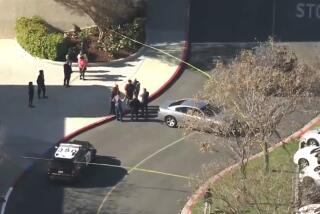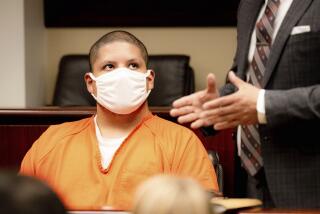Details of Oregon mall gunman’s last hours emerge
He left no angry manifesto. The last night he was alive, Jacob Tyler Roberts stayed up late drinking and shooting pool with a buddy.
Roberts told his friend Sean Cates that he needed a gun, but he didn’t say why. The pair, hanging out in Portland, Ore., smoked pot, got drinks from a 7-Eleven and ended up at a Denny’s at 3 a.m.
The two crashed at Cates’ apartment, and when Cates woke up, Roberts was gone — along with Cates’ AR-15 rifle.
By the time Cates rose from bed at 4 p.m. Dec. 11, three people were already dead at the Clackamas Town Center mall outside Portland.
One of them was Roberts, 22, a seemingly happy-go-lucky skateboarder who had stormed through a Macy’s, leveling his gun, waist-height, on the shoppers who had gathered to buy holiday gifts. He wore a white mask.
Roberts’ last hours — the drinking, the smoking and an odd confession made before the carnage — are detailed in hundreds of pages of police reports and witness accounts released last week by the Clackamas County Sheriff’s Office. The violence shocked a nation reeling from shootings at a Colorado movie theater and a Sikh temple in Wisconsin months earlier, but it faded from view when another gunman opened fire at an elementary school in Newtown, Conn., three days later.
In interviews with authorities, friends and acquaintances of Roberts plumbed the complexities of the young man’s personality, but the intensive investigation offers no explanation of why he sprayed 16 rounds around the center of the mall and then sent a 17th through his own head.
The report and supporting documents do, however, capture the outlines of a dark side Roberts hid from others and provide a narrative of the chaos and sorrow that followed his rampage:
One of his bullets struck Cindy Yuille, 54, in the back; Yuille, who was a nurse, a wife and a mother, fell to her knees and died before another nurse nearby could save her.
Another of Roberts’ bullets struck Steven Forsyth, 45, in the head while Forsyth was speaking to his father on the phone. He had just opened a new kiosk in the mall for the holiday season; he died where he fell.
Kristina Shevchenko, 15, was shot in the back as she ran away. She survived, even after the high-velocity round from Roberts’ AR-15 shattered inside her body. Another shopper was narrowly spared: A bullet ripped through her jacket but missed her body.
Roberts, an employee at a sandwich shop, had no history of violence and was known as a joker by his friends. He’d shot guns before but was uncomfortable with hunting. Ten days before the shooting, he broke up with his girlfriend after announcing a sudden plan to move to Hawaii.
Yet he didn’t appear to be sad about the break. Friends told police the announcement was surprising but not totally out of character for the spontaneous Roberts, who appeared to be excited for the move to Hawaii planned for Dec. 8.
Except Roberts never left Oregon. He told friends he got drunk and missed his flight.
That day, he began buying .223-caliber ammunition and shooting targets at a local Wal-Mart. He also bought 30-round magazines at a local gun shop, even though he did not own a .223-caliber rifle.
Three hours before the shooting, Roberts briefly stopped by his own apartment in Portland to get some clothes and made awkward small talk with his roommates, mentioning something about maybe helping a friend move. Later that afternoon, Roberts stopped by the apartment of a friend, Tyler Eheler, who lives two miles from the mall.
Eheler later told police Roberts asked if he could crash at Eheler’s apartment because he had killed someone — and Eheler said no. Eheler told police that Roberts was vague and awkward about his plans to leave town, with Roberts saying he planned to drive someplace warm.
Roberts hugged his friend twice, awkwardly, before leaving, Eheler told police.
Fifteen minutes later, Roberts charged into the mall.
He was found dead in a side hallway. Eheler later speculated that Roberts was confessing to the crime he was about commit, not a killing he’d already perpetrated.
The report also captures the distress of survivors after the shooting. Roberts’ aunt, who raised Roberts before they became estranged, threw up when police told her what he had done.
Forsyth’s father, Ron, was besieged by reporters after his son’s death and has taken to woodworking to cope. His wife of 45 years had died of ALS years before, and he was crying when friends called him to deliver their sympathies. He also described facing the media.
“Ron had a list of local and national media who were calling and leaving messages trying to get him to talk,” wrote one detective who visited him two days after his son’s death. “He was really upset over one message where the reporter wanted him to call to confirm the story [that] Steven physically fought for his life. If Ron didn’t call him back, the reporter was going to run with the story.”
After news of the shooting broke Dec. 11, Roberts’ friends quickly came forward to speak with police on suspicion that Roberts might have been involved. His roommates found empty boxes of ammunition in his room.
Many related sensing the edges of a persona Roberts rarely showed: frustration at being estranged from his father and losing his biological mother when he was young; frustration at breaking his ankle while skateboarding and not being able to join the Marines; a mask of jokiness that sometimes made his true feelings a little hard to read. When he spoke with an ex-girlfriend, he was crying, saying he was “lost.”
Investigators found little direct digital evidence pointing toward an attack, though they learned he was peddling his possessions on Craigslist, including his couch and Volkswagen Jetta. On his laptop, along with porn, they recovered an old Word file he’d apparently written in an autobiographical third-person:
“There was a man I once knew. He was a good kid at heart, but there are things in this world that can make a man change in a heartbeat. His life was not so good but he didn’t let the people around him in on what was really going on. He put a mask on his face to show his true side.”
The file had been deleted.
When police discovered Roberts’ body, the white mask he’d been wearing was sitting in a pool of his blood.
The suicide blast from his rifle had disfigured him. Police identified him from the tattoo on his left biceps: two masks, one smiling, one crying.
More to Read
Start your day right
Sign up for Essential California for news, features and recommendations from the L.A. Times and beyond in your inbox six days a week.
You may occasionally receive promotional content from the Los Angeles Times.







